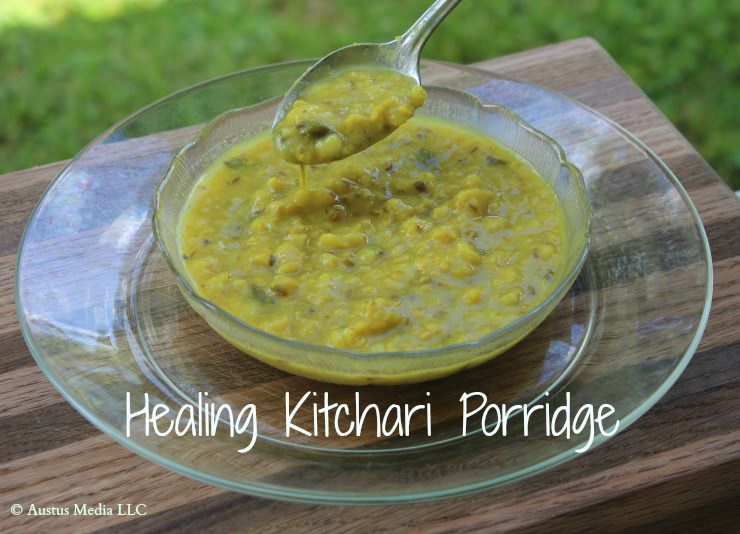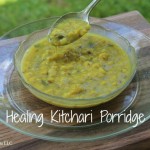Table of Contents[Hide][Show]
 The small, locally owned health food store where I have shopped for nearly 20 years has a wonderful deli and juice bar. It is a huge favorite of the locals. I frequently drop in to see what homemade soups are available on the hot bar. My family consumes so much homemade soup and nourishing bone broth each week that I sometimes find it difficult to keep up. Having a quality source for these foods to lend a hand is very helpful, I can tell you!
The small, locally owned health food store where I have shopped for nearly 20 years has a wonderful deli and juice bar. It is a huge favorite of the locals. I frequently drop in to see what homemade soups are available on the hot bar. My family consumes so much homemade soup and nourishing bone broth each week that I sometimes find it difficult to keep up. Having a quality source for these foods to lend a hand is very helpful, I can tell you!
Recently, I’ve noticed that the hot bar regularly features a pot of kitchari. This was exciting to me, as this is one of the very first traditional dishes I learned about when I began cooking at home. I was forced (thankfully) to stop eating out so much at the urging of my amazing doctor at the time. She is an Ayurvedic physician and an MD.
It’s so neat when something a bit obscure that you’ve enjoyed for a long time starts to mainstream!
Kitchari is a nutritious, tasty and very digestible dish from India.
Indian mothers frequently make for their children when they are feeling under the weather. The soothing nature of this healing and nourishing porridge makes it perfect for a light supper, A brief kitchari fast rests digestion and is a wonderful dish to take to convalescents and mothers who have recently given birth. Another helpful dish for the sick is potassium broth.
Vata Churna Spices Used in Kitchari
The spices are what really make kitchari so special. The spice blend is called Vata Churna which represents all six tastes – sweet, salty, sour, bitter, astringent, and pungent – in a single dish. This is what accounts for the balanced satisfaction a meal of kitchari bestows upon the tastebuds and the digestion with nothing more required. Salted lassi is another common food in the Ayurvedic tradition that uses similar warmth inducing herbs.
Quality Vata Churna is Key to Tasty Kitchari
High quality Vata Churna can be purchased already blended here. You can also easily make it yourself.
To make a batch of Vata Churna that will make several small pots of kitchari, follow these instructions:
- Lightly roast 2 tablespoons each of cumin and coriander seeds in a dry skillet until you smell the nutty fragrance. This only takes a minute or two.
- Remove from heat and cool.
- Process 1/2 teaspoon of whole cardamom seeds with the roasted cumin and coriander in a spice grinder until a fine powder.
- Mix in 1 teaspoon of ground licorice, 1/2 teaspoon of ginger powder, 1/4 teaspoon of hing powder, and 1/4 teaspoon of finely ground sea salt.
Note: The hing powder is a very important spice although it’s not something typically found in the spice drawer of a Western home. Be sure to include as it helps digest the mung beans in the kitchari.
Once you have the Vata Churna spice blend ready either by purchase or making it yourself, you are ready to make a pot of kitchari.
Kitchari Ayurvedic Porridge
The recipe for kitchari can be enjoyed any time of year. Winter is particularly helpful as the herbs are warming on a cold night. Those with a fever or who are recovering from illness particularly benefit.

Homemade Kitchari Porridge
Easy recipe for kitchari that is excellent warming dish for cold winter nights and for those recovering from childbirth, illness, or surgery.
Ingredients
- 1/4 cup sprouted mung beans
- 1 tsp Vata Churna spice blend
- 1/4 cup white basmati rice preferably organic
- 2 3/4 cups filtered water
- 3 Tbl ghee preferably grassfed
- 1 tsp ground cumin preferably organic
- 1 tsp mustard seeds preferably organic
- 1 tsp sea salt
Instructions
-
In a large saucepan, bring 1 1/2 cups of filtered water to a boil.
-
Add the sprouted mung beans, salt, and Vata Churna spices. Bring back to a boil, then cover and reduce heat to a very low simmer.
-
After cooking for one hour, add the rice, 2 tablespoons of ghee, and the remaining 1 1/4 cups water. Bring mixture to a boil again. Stir, and reduce heat to a simmer and cook for an additional 30 minutes.
-
Stir as often as necessary to avoid sticking. Add more water as necessary if the kitchari becomes too thick noting that the proper consistency is of thick gravy.
-
When the kitchari is finished cooking, heat the remaining 1 tablespoon of ghee in a small pan with the mustard seeds and cumin. When the mustard seeds pop, stir the mixture into the kitchari and serve.
-
Refrigerate unused portions and reheat on the stovetop to serve (don't microwave).
Recipe Notes
Sprouted or soaked lentils may be substituted for mung beans if desired.
Sprouted brown or wild rice may be substituted for white rice.
In case of dairy allergy, substitute expeller pressed coconut oil instead of ghee.
Sarah, The Healthy Home Economist
Sources and More Information
Cooking for Life: Ayurvedic Recipes for Good Food and Good Health








Hing gives a special taste .
Is this okay for a 10 month old?
I would recommend waiting until after a year old because kitchari contains grains.
In India, both dal (lentil soup) and rice are given to children above 6 months.
Rice is one of the most easily digestible foods. Nearly all of it is easily digestible starch which can be digested by the body without use of any bacteria. The rice should be fresh. Similarly for moong lentils. Just the moong should be split with cover removed. The cover is difficult to digest. Don’t use other lentils, they are not as easy to digest.
But this tradition may not be ideal.
I am an Indian. We make it slightly differently. We don’t use whole moong. Whole moong is more difficult to digest than split moong. Actually, the name DAL means split lentils.
It is essentially the sick meal in nearly whole of India. Curd is used to further increase its digestibility, and ghee cools the digestive system. One tip, if you want to have spices but cannot handle them add cream, you will not feel the spice. Ghee does that too, not to the same extent. But it much easier to digest as well.
We normally don’t put any spices in it, if it is for the sick, as they would reduce the digestibility. Heeng (Asaffoetida) is required only if the moong is not split.
The consistency of khichdi is thick and flowing. We normally mash the rice and dal after cooking, as that further increases the digestibility.
Sometimes we have it has a comfort food too. Then lots of ghee is added. Sometimes we use different lentils, like whole moong, or even urad. In these cases a Tadka is added with Heeng and Garlic, and possibly cumin and dry broken chilli.
Good to see it is getting popular there :-).
Small comment. I think you are using “brief fast” incorrectly. A fast is when you cease eating, even brief cessations such as when you go to sleep (thus, the reason for the name of the meal called “breakfast” — with that particular meal, you are breaking the nightly fast whilst you were asleep).
I think the word you might have meant was “repast” (which kind of rhymes with the above mentioned “fast”) which, itself, means “a meal” but many people also use to mean a small light dish, much like a fulfilling snack.
There are different types of fasts. Juice fasts, water fasts, raw milk fasts. Fasting doesn’t necessarily mean no food whatsoever.